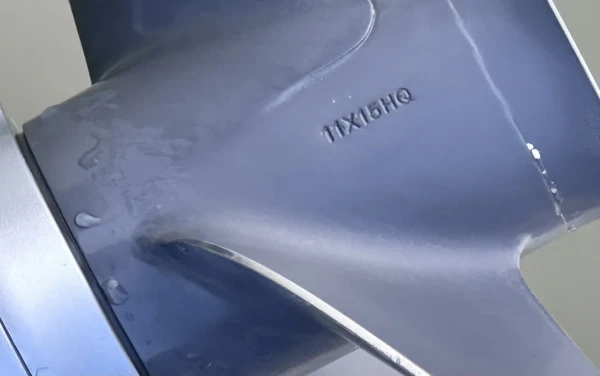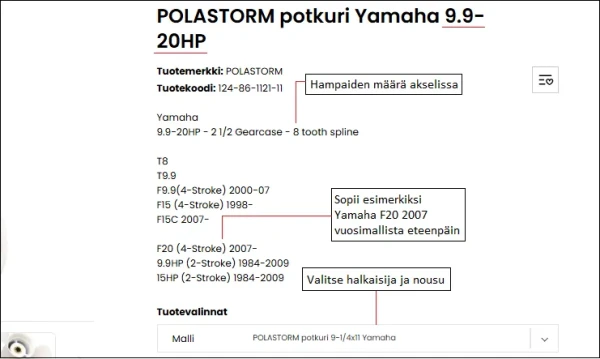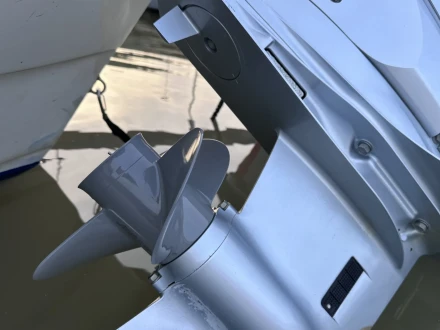Choosing the Right Propeller for Your Boat – A Guide to Selecting a Propeller
How do I choose the right propeller for my boat? A boat’s performance and fuel efficiency are key factors when boating. Choosing the right propeller has a direct impact on your boat’s acceleration, top speed, fuel consumption, and handling. This guide covers the most important things to consider when selecting a propeller for recreational boating, how to read propeller markings, and the differences between three-blade and four-blade propellers.
Guide to Choosing the Right Propeller - Technical Measurements and Features
Diameter and Pitch – The Basic Measurements of a Propeller
- Diameter: The diameter of a propeller is measured by determining the distance across the circle traced by the tips of the blades and converting the unit to inches. Diameter affects how efficiently the propeller moves water. A larger diameter improves the propeller’s thrust due to increased blade surface area. A smaller diameter paired with a higher pitch results in better top speed, while a larger diameter and lower pitch provide better acceleration.
- Pitch: Pitch refers to the theoretical distance the propeller would move in one revolution through a solid, measured in inches. The pitch influences your boat’s top speed and acceleration. For example, the marking "9x11" means the propeller has a 9-inch diameter and 11 inches of pitch.
Understanding these measurements correctly will help you choose the right propeller.
Interpreting Propeller Markings
The markings found on the side, blades, or tip of a propeller provide important information about its features:
- Diameter: Usually indicated in inches. For example, the marking 9 ¼ x 11 tells you the propeller has a 9 ¼ inch diameter (the first number).
- Pitch: Pitch is marked in the same unit as the diameter, which is inches. In the example 9 ¼ x 11, the second number (11) represents the pitch.

Propeller markings: 11-inch diameter and 15-inch pitch.
How Do I Choose the Right Propeller for My Boat?
First, consider what kind of effect you want the new propeller to have on your boat’s performance. If you want to restore the exact same performance you had previously, for example, before the propeller hit a rock, you can check the propeller’s markings and choose a new one with the same specifications, as long as it fits the propeller shaft. To ensure compatibility, find out your engine’s brand, model, year of manufacture, and count the number of splines on the shaft, either from the shaft or the old propeller. You can find corresponding specs in our online store as follows:

Selecting a propeller on Netkone.fi online store
Troubleshooting – Practical Examples
If your boat is experiencing a performance issue and the boat and engine are otherwise in good condition, we recommend trying a different propeller according to the table below.
| Problem | Solution | Practical Example |
| Boat gets on plane slowly or accelerates slowly | Lower pitch and/or larger diameter |
9 ¼ x11 → 9 ¼ x10 Reducing the pitch |
| The boat accelerates quickly, but increasing the RPMs at the top end no longer affects maximum speed | Higher pitch and/or smaller diameter |
9 ¼ x10 → 9 ¼ x11 Increasing the pitch |
| I want better acceleration for the boat | Lower pitch and/or larger diameter |
9 ¼ x11 → 9 ¼ x10 Reducing the pitch |
| I want higher top speed for the boat | Higher pitch and/or smaller diameter |
9 ¼ x10 → 9 ¼ x11 Increasing the pitch |
If you increase the propeller's diameter: Make sure the larger diameter will fit and can rotate properly.
How many blades should the propeller have?
The most common propellers for recreational boats have 3 or 4 blades. The number of blades affects the propeller's grip and drag. More blades provide better grip and less slippage compared to a propeller with fewer blades. You can think of it as a greater number of blades increasing the propeller's total blade surface area, allowing it to move water more efficiently. However, as the number of blades increases, maximum speed decreases, because the larger surface area also creates more drag in the water. A 3-blade propeller is often a good choice for regular boats with an outboard motor.
Stainless steel or aluminum propeller?
For recreational boating, aluminum propellers are the most common, but stainless steel propellers are also widely used. Aluminum propellers are often favored because they're affordable and usually don't damage the shaft if you hit a rock. They act like a fuse: when you run aground, the propeller gets damaged but the shaft often remains straight. Also, replacing a new aluminum propeller is much cheaper than repairing a damaged shaft.
Stainless steel propellers are also a great option—in some cases even better than aluminum. The choice of material mainly depends on how the boat will be used. For outboards under 80 horsepower, aluminum is generally preferred, but as power increases, a stainless steel propeller makes more sense, as it’s more durable and rigid.
Summary: How to choose the right propeller
Choosing the right propeller is an important investment that affects your boat’s performance, fuel efficiency, and the engine’s lifespan. Sometimes, determining the ideal propeller requires a bit of practical experimentation and the courage to try a new one. By taking the following factors into consideration, you'll choose the right propeller:
Diameter and pitch: Find out the measurements of your current propeller and consider what kind of changes you'd like to see in your boat’s performance. Often a small adjustment in the pitch will give the desired result.
Technical markings: Read and understand the propeller markings so you know exactly what benefits changes to the dimensions provide.
Number of blades: Choose the number of blades according to your intended use.
Material selection: Choose the material based on your intended use and considering your engine’s power.
Find the perfect solution for your boat – explore our wide selection of propellers!
